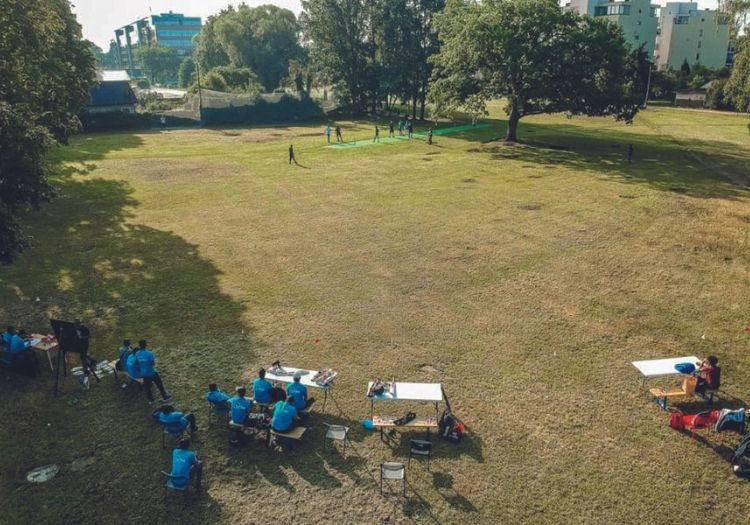
James Coyne reports from Rīga on how a great Latvian Olympian javelin thrower pencilled himself into cricket history
Not too many people have been on a plane lately. But if you do happen to touch down in Rīga International Airport, before all your Covid-era documentation is checked you will be greeted by a handsome photo gallery of Latvia’s finest Olympians. First on the roll-call is the great javelin thrower Jānis Lūsis.
Lūsis competed in four Olympic Games for the Soviet Union, winning bronze in 1964, gold in 1968 and silver in 1972 – and was denied back-to-back Olympic titles by West Germany’s Klaus Wolfermann by just two centimetres, then the smallest margin applied in the javelin. Lūsis died in April 2020, aged 80.
You’re probably wondering what this has to do with cricket. Well, a few months before Lūsis’s death – spurred on by initial investigations made by The Guardian’s Andy Bull – I called him up at home, to quiz him on his obscure part in cricketing history.
For it has long been enshrined in the farthest reaches of Wisden Cricketers’ Almanack that Lūsis was reported as having thrown a cricket ball 150 yards (137 metres). If true, that is a world record in Throwing the Cricket Ball, once a staple competition of sports days in Victorian days.

The matting wicket (and trees) at Turība University
I can imagine how, during a field athletics meet somewhere in the Commonwealth, a wag in search of a Rocky IV-style ‘east-meets-west’ tale presented this Soviet champion with a tattered old cricket ball and asked him to chuck it as far as he could.
Happily – and not just for this purpose, rest assured – my wife Baiba is from Latvia, and so she was able to ask Lūsis in his own tongue whether he remembered hurling a bizarre red ball covered in leather.
“It’s possible I did it,” Lūsis told her. “I’ve thrown stones further than that!”
(Baiba was instantly transported back to her own school PE lessons, when they would be tasked with hurling metal balls as training for field events. She suspects Lūsis was probably referring to that.)
Sadly, Lūsis couldn’t remember the cricket ball with any clarity. Well, we did our best. So for now Robert Percival clings on to the trusted record of 140 yards and two feet, set at Durham Sands Racecourse in 1882.
The Window: Machine takes its toll on Stokes
Mercifully – and remember Lūsis was trying to throw a cricket ball away – there is more to Latvia’s cricketing story than just this curio. The sport has more than a century’s heritage in elegant Rīga, though two rather well-documented occupations did put a halt to it.
After Latvia’s first hard-won independence from Russia in 1918, the United Baltic Corporation of London started running passenger and cargo ships to Rīga. During this interwar period of relative freedom and national prosperity still looked on rosily by most Latvians, regular notices would appear in Latvian and German-language newspapers advertising Riga CC’s weekend matches.
Riga CC initially played in Peters Parks, on the western bank of the Daugava. But after a local policeman insisted on monitoring this peculiar game from short midwicket and was struck painfully on the head, the cricket club was packed out to the genteel Mežaparks forest suburb, where they rented from the Baltic German sports club SV Kaiserwald. When the Nazis invaded Latvia in 1941 they installed a concentration camp in Mežaparks; I could find no evidence of the sports ground among all the pine forests and cemeteries today.
As for Peters Parks, it is now Uzvaras Parks (Victory Park). You won’t be able to miss the giant, brutalist, red-starred, war monument installed there by the triumphant Soviet authorities to celebrate defeat of the Nazis.

The late Jānis Lūsis welcomes travellers at Rīga International Airport
That was it for cricket until Latvia’s second independence in the 1990s. One of the better legacies of the communist era is a strong health sector, and across cities in the former Eastern bloc young South Asians (mostly men) have snapped up the opportunity to study medicine in their proud institutions.
Today’s Latvian Cricket Federation draws on teams from Turība University, Riga Technical University and ISMA University, plus the clubs Riga United, Kipsala Wolfpack and Discover Cars. The best players represent Latvia in the Baltic Cup each summer against Estonia and Lithuania, and sometimes further afield. Latvia were notable for refusing to risk their bodies by taking part in Estonia’s Cricket on Ice tournaments, held in a disused Soviet missile factory.
In 2012 I toured Poland and the Baltic states with Carmel & District CC of North Wales, and we played Latvia at their old ground next to Tukums Airport – an hour’s drive west out of Riga. I hazily recall a combination of Indian chai and Latvian pīrāgi pasties.
Now cricket has some of its central visibility back: hardball and tapeball matches are part of Riga campus life at Turība University, who have installed a matting wicket on a patch of grass in full sight of the business school buildings and accommodation blocks.
There is the small issue of a huge tree where short midwicket would stand – but I suppose that’s preferable to a copper’s skull. While Latvian law entitles every citizen to dig up one tree a year, that applies only to fir trees at Christmas-time. So Latvia’s cricketers will have to make do with the foliage for now.
This article was published in the Summer edition of The Cricketer - the home of the best cricket analysis and commentary, covering the international, county, women's and amateur game